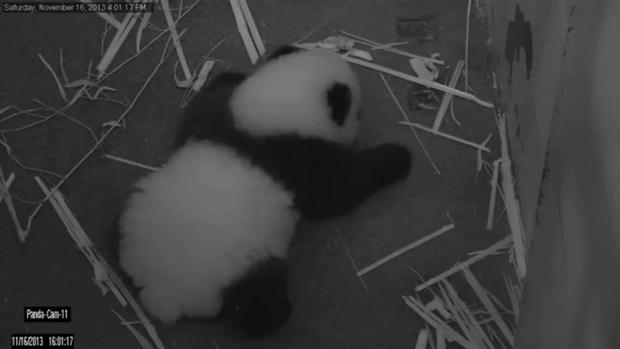National Zoo's panda cams: Behind the scenes
Amid hundreds of thousands of federal workers slated to be furloughed and national parks and monuments that would stand neglected, it was the niche narrative of the 2013 government shutdown: The Smithsonian National Zoo's live animal web cameras were going to go dark.
It had been just over a month since Aug. 23, when the zoo's resident giant panda, Mei Xiang, gave birth to a female cub. And, thanks to a sponsorship from the Ford Motor Company, what was already the zoo's most popular webcam offered viewers the chance to see the delivery - and the cub's subsequent development - in high definition.
"We saw things this year that we have never seen before," said Brandie Smith, senior curator at the zoo, and of giant pandas. "We saw Mei Xiang's water break. When we saw the cub being born, I think people will agree the images they saw were pretty close to what they would get if they were watching them themselves."
It's drawn a considerable viewership. Smith says the feedback she most often gets about the cameras is primarily "people saying they're addicted to the panda cams, and that we need to stop them so that they can get some work done, or get their house cleaned."Shannon Pawley, on a zoo visit during a November trip from Detroit, described herself as a panda cam addict: "A lot of times I'll turn it on when I'm cooking," she said. "Or when I'm sitting and reading a book, and I'll have the panda cam on. Then I'll see some movement, and I'll stare at the pandas a little bit, then I'll get back to my book."
But it's not just fans watching. The 15 cameras in the panda exhibit are funneled onto two web streams by volunteers, who have also been trained to observe and record giant panda behavior. Leslie Wilkes, who's been volunteering since Mei Xiang's first birth in 2005, says watching the pandas is "just really fun."
"I'm monitoring Mei Xiang's behavior toward the cub - so how much time she spends with the cub, how she takes care of the cub," Wilkes said. "One of her functions is to groom the cub, and so that's a piece of data that I record as she does it. I put a checkmark in each column as the behavior occurs, and I record that at one-minute intervals."
And that's no small task. Wilkes's usual shift is from 7 a.m. to 10 a.m., one day a week - or, 180 minutes.
The cameras are manned from 7 a.m. to 10 p.m. ET, but they're broadcast 24/7. Wilkes says at the end of the workday, "we leave a wide frame on the cub in the den, and we leave a wide frame on the room immediately outside of the den, so that if Mei comes out on the rocks, she'll be in view."
It's the "perfect blend," she says: video entertainment for an international audience, via cameras the zoo needs to help monitor its animals.
"One of the goals of having giant pandas here is to make more giant pandas," she said. "It's an endangered species, and so the more giant pandas we can produce, the better. So we're learning about how mothers take care of their offspring, looking for different ways that they relate, how their offspring responds, and just to make sure they're doing well; that she's getting fed, she's getting cared for, everything's going well."
Wilkes says her workload includes tracking proximity: Whether they're touching, if Mei Xiang is within one body length from her cub, or if she's out of range - a "proxy," she said, "for if she's paying attention to the cub or off eating or taking care of herself."
The animal cam craze began in 1995, with the naked mole rat camera. It began as a tool in long-distance learning for a practicum with Eleanor Roosevelt High School, and almost two decades later, Smith says parents are still using it as a fun educational tool for their kids.
"They can talk about the pandas, about animals, about science, about conservation," she said. "So that's a really spectacular thing that we're able to provide."
The naked mole rat, as well as the giant octopus - "some of the more interesting species," Smith says - stand among the most popular cameras, as well as the panda cam and the tiger cub cam. The zoo's now up to 14 cameras - and counting.
"We're actually in the process of setting up a camera on our sloth bear," Smith said. "She's starting to den up; we're hoping to have a cub this winter. And so we're setting up a camera so that we can start to monitor her around the clock. And then what we'll do is we'll have discussions about whether that's an internal camera for husbandry purposes, or if it's something that we want to broadcast."
Smith says the virtual experience is "great," but it's "only part of" the what the zoo has to offer.
"You see those close-up shots of the panda cub on the webcam, and you just want to see her in person," she said. "I actually think it brings a lot of people to the zoo."


